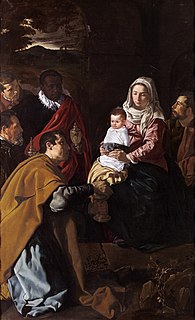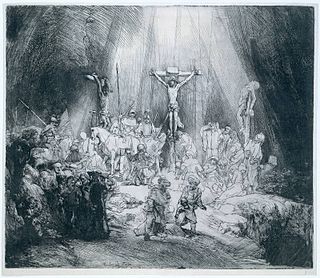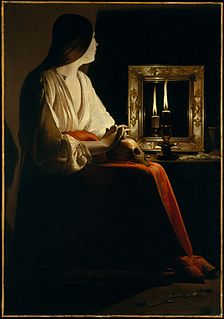Related Research Articles

Andrea Andreani (1540–1623) was an Italian engraver on wood, who was among the first printmakers in Italy to use chiaroscuro, which required multiple colours.

Chiaroscuro, in art, is the use of strong contrasts between light and dark, usually bold contrasts affecting a whole composition. It is also a technical term used by artists and art historians for the use of contrasts of light to achieve a sense of volume in modelling three-dimensional objects and figures. Similar effects in cinema, and black and white and low-key photography, are also called chiaroscuro.

Paolo Caliari, known as Paolo Veronese, was an Italian Renaissance painter based in Venice, known for extremely large history paintings of religion and mythology, such as The Wedding at Cana (1563) and The Feast in the House of Levi (1573). Included with Titian, a generation older, and Tintoretto, a decade senior, Veronese is one of the "great trio that dominated Venetian painting of the cinquecento" and the Late Renaissance in the 16th century. Known as a supreme colorist, and after an early period with Mannerism, Paolo Veronese developed a naturalist style of painting, influenced by Titian.

Francisco de Zurbarán was a Spanish painter. He is known primarily for his religious paintings depicting monks, nuns, and martyrs, and for his still-lifes. Zurbarán gained the nickname "Spanish Caravaggio", owing to the forceful use of chiaroscuro in which he excelled.

Georges de La Tour was a French Baroque painter, who spent most of his working life in the Duchy of Lorraine, which was temporarily absorbed into France between 1641 and 1648. He painted mostly religious chiaroscuro scenes lit by candlelight.

Alessandro Bonvicino, more commonly known as Moretto, or in Italian Il Moretto da Brescia, was an Italian Renaissance painter from Brescia, where he also mostly worked. His dated works span the period from 1524 to 1554, but he was already described as a master in 1516. He was mainly a painter of altarpieces that tend towards sedateness, mostly for churches in and around Brescia, but also in Bergamo, Milan, Verona and Asola; many remain in the churches they were painted for. Most are on canvas, but a number even of large ones are on wood panel. Only a handful of drawings survive.

Girolamo Francesco Maria Mazzola, also known as Francesco Mazzola or, more commonly, as Parmigianino, was an Italian Mannerist painter and printmaker active in Florence, Rome, Bologna, and his native city of Parma. His work is characterized by a "refined sensuality" and often elongation of forms and includes Vision of Saint Jerome (1527) and the iconic if somewhat anomalous Madonna with the Long Neck (1534), and he remains the best known artist of the first generation whose whole careers fall into the Mannerist period.

The Denial of Saint Peter(La Negazione di Pietro) is a painting finished around 1610 by the Italian painter Caravaggio. It depicts Peter denying Jesus after Jesus was arrested. The painting is housed in the Metropolitan Museum of Art in New York City.

Aert de Gelder was a Dutch painter.

Artus Wolffort, Artus Wolffaert or Artus Wolffaerts (1581–1641) was a Flemish painter known mainly for his history paintings depicting religious and mythological scenes.

Matthias Stom or Matthias Stomer was a Dutch, or possibly Flemish, painter who is only known for the works he produced during his residence in Italy. He was influenced by the work of non-Italian followers of Caravaggio in Italy, in particular his Dutch followers often referred to as the Utrecht Caravaggists, as well as by Jusepe de Ribera and Peter Paul Rubens. He did not share the other Northern Caravaggisti's preference for humorous, and sometimes scabrous, genre scenes and elaborate decorative allegories but favored stories from the bible instead. He worked in various locations in Italy where he enjoyed the patronage of religious institutions as well as prominent members of the nobility.

The Adoration of the Magi is a 1619 Baroque painting by the Spanish artist Diego Velázquez now held in the Museo del Prado. It shows three kings presenting gifts to the Christ child: Melchior, who kneels in the foreground; Balthazar, who stands behind him wearing a red cape and a lace collar; and Caspar, who appears between the other two. An unidentified young man who stands behind Balthazar is looking on. Kneeling near the Virgin's left shoulder is Saint Joseph. The size and format of the painting indicate that it was made for an altarpiece.

Old Woman Frying Eggs is a genre painting by Diego Velázquez, produced during his Seville period. The date is not precisely known but is thought to be around the turn of 1618 before his definitive move to Madrid in 1623. The painting is in the Scottish National Gallery in Edinburgh. Velázquez frequently used working-class characters in early paintings like this one, in many cases using his family as models; the old woman here also appears in his Christ in the House of Martha and Mary (1618). There is some dispute about what cooking process is actually depicted with some suggesting not frying but poaching, leading to an alternative title of the painting, Old Woman Cooking Eggs or Old Woman Poaching Eggs.

The Three Crosses is a 1653 print in etching and drypoint by the Dutch artist Rembrandt van Rijn, which depicts the crucifixion of Jesus Christ. Most of his prints are mainly in etching and this one is a drypoint with burin adjustments from the third state onwards. It is considered "one of the most dynamic prints ever made".

Feast in the House of Simon the Pharisee, also known as Christ in the Home of Simon the Pharisee, is a painting by Peter Paul Rubens. It was painted c. 1618–1620, and is in The Hermitage Museum, St. Petersburg.

The Bob Jones University Museum & Gallery is the art collection of the Bob Jones University in Greenville, South Carolina. It was established in 1951, and focuses on sacred art, mainly European Old Master paintings, but also smaller collections of sculpture, furniture, architectural elements, textile, and ancient artifacts. As of 2017, it is closed for renovation and expected to reopen in 2019.}}

The Magdeburg Ivories are a set of 16 surviving ivory panels illustrating episodes of Christ's life. They were commissioned by Emperor Otto I, probably to mark the dedication of Magdeburg Cathedral, and the raising of the Magdeburg see to an archbishopric in 968. The panels were initially part of an unknown object in the cathedral that has been variously conjectured to be an antependium or altar front, a throne, door, pulpit, or an ambon; traditionally this conjectural object, and therefore the ivories as a group, has been called the Magdeburg Antependium. This object is believed to have been dismantled or destroyed in the 1000s, perhaps after a fire in 1049.

Magdalene with Two Flames or The Penitent Magdalene is an undated work created c.1640 by the French painter Georges de La Tour. In 1978 Mr. and Mrs. Charles Wrightsman gave it to the Metropolitan Museum of Art in New York, where it still hangs.

The Feast in the House of Simon the Pharisee is an oil on canvas painting by Paolo Veronese, completed in 1570 for San Sebastiano, a Hieronymite monastery in Venice. He also produced a cycle of works for the monastery church, where he was later buried. After the French occupation of Venice in the late 18th century, the monastery was suppressed and its art confiscated. In 1817, after the fall of Napoleon, Feast was assigned to the Pinacoteca di Brera in Milan, where it still hangs.
References
- ↑ Jan Johnson, 'Alessandro Gandini: Uncovering the Identity of a Chiaroscuro Woodcutter', Print Quarterly, Vol. XXX, No. 1, 2013, pp. 3-13.
- ↑ "Christ in the House of Simon the Pharisee (Accession No. 22.67.42)". Metropolitan Museum of Art . Retrieved 9 July 2015.